TRADITIONAL CHINESE AGRICULTURE
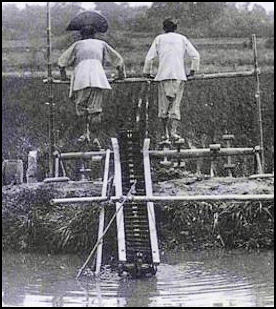
Foot-powered irrigation The history of agriculture in China has been one of constantly improving crop yields through innovations, improvements in techniques and intensification. The resulting surpluses have allowed the population to grow.
In late imperial times the agricultural land in the north was worked by people who owned the land while the land in the south was owned by landlords who didn’t work the land themselves. Peasant who worked the land either paid for use of the land with a share of their harvest, a fixed rent in crops or a fixed rent in cash. It was more of commercial arrangement than a feudal one.
Agriculture in China is labor intensive. Women do about 60 percent of the work. Animals such as mules, oxen and water buffalo are considered luxuries and most plowing is done with sticks or hoes by farmers in lamp shade hats and rubber boots. Human excrement, urine and even burnt duck feathers are brought into the fields and used for fertilizer.
Chinese farmers are very efficient. In the Guangdong province farmers plant three crops a year: two of rice and one of legumes. The rice paddies also double as fishponds, and the dikes between them are often planted with sugarcane and mulberry trees. Chinese farmers can also be very clever. When the price of carrots went down one farmer found it was more profitable to use the carrots to fatten his pigs, when the price of carrots went up he sold the carrots on the market.
Peasant farmers in the south have traditionally used water buffalo to plow their fields, donkeys to carry goods and treadmills to pump water into irrigation ditches. Theft is sometimes a problem. During harvest time families often sleep in the fields or by their fish ponds.
Articles on AGRICULTURE IN CHINA factsanddetails.com and RURAL LIFE IN CHINA factsanddetails.com
Irrigation, Water and Agriculture in China
Agriculture and irrigation account for large amounts of all water use. Water for irrigation can from wells, rivers, canals, lakes, ponds and reservoirs. Often dams are built to supply water for irrigation. There is 545,960 square kilometers of irrigated land in China. Forty percent of China’s crop land is irrigated, compared to 23 percent in India. The average yield per acre in China is double that of India.
Pumps are important for irrigation. In the old days water wheels and manual labor were needed to lift water from wells, rivers, canals and ponds to agricultural land. Now gasoline- and diesel-powered pumps do much of the work. Pumps may be noisy but are a relatively cheap and efficient. Foot-powered pumps, using a 2000-year-old design are being resurrected and used not only in China but in Africa and other parts of world as an ecofriendly that doesn’t require a lo of energy and draws water in a sustainable way so as not threaten groundwater supplies.
Studies in South Asia have shown that a traditional treadle water pump — operated by a person on a device that looks a bit like a Stairmaster stair climber — can increases the income of farmers by 25 percent. First introduced to Bangladesh in the 1980s and now widely used in Asia and sub-Sahara Africa, these pumps are easy to install and simple to operate and often deliver higher crops yields than those obtained using diesel pumps.
Irrigation Systems in China
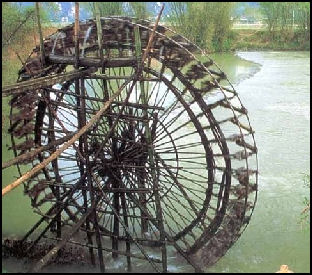
Irrigation water wheel Water used in irrigation often times originates from sources miles away and sometimes uses tunnels, aqueducts and canals that were built over a 1000 years ago. The water often flows from the source in a single canal which in turn divides in smaller canals that lead to the fields There may thousands of fields, each averaging about from a few acres to may dozen acres in size, or huge swaths of agricultural land.
The water flowing in and out is regulated by a complex process that has been fine tuned over the centuries. In many places water is distributed by opening and closing gates which provide water to certain area for a specific amount of time. Some places still use water clocks (a pot with a small hole in the bottom that measures out about three minutes) to determine when the gates of the irrigation system
The schedule for distributing water is may by an annual calendar. The various stages of growing process — the flooding of the fields, the transplanting of sampling and the harvesting of the nature crop — are all determined by the calendar and sometimes each stage is marked by festivals and rites.
The distribution of water is often overseen by individuals who follow customs and rules ro determines which fields get water when. In traditional societies the water is often distributed through a system based on fairness and equity in turn based on family size and land holdings. Each member of the community is entitled to their share as long as they fulfill their duties in maintaining the system. In corrupt system, water is often diverted to large landowners who produce cash crops which the government receives taxes or kickbacks.
Problems with Irrigation in China
Irrigation with canals is very inefficient. Lots of water is lost to evaporation, run offs and absorption into the soil before it reaches crops. Governments are often to blame for these practices because they subsidize water so heavily that farmers have little incentive to save it
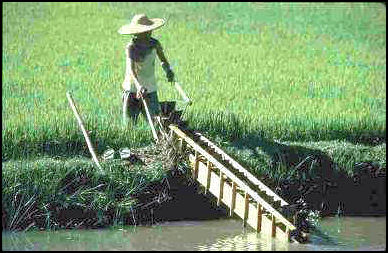
Modern irrigation pump Poorly-drained irrigated land leaves behind salt deposits as water evaporates. In many places, fields that once grew bountiful crops of grains are now encrusted in salt. More than a quarter of the world's irrigated land has become so salty that many crops will no longer grow there. To make the land productive again the fields have to be flooded four times to clear away the salt.
Irrigation also causes large amounts of salts, fertilizers and pesticides to be flushed into rivers and streams. Short supplies of water can result in increased in disease as untreated sewage water is used in irrigation.
The drilling of wells for irrigation, farming and animal herding can trigger an unhealthy cycle. Drilling wells causes the water table to drop. After a while the water may become too salty for crops and animals or too expensive to pump resulting in the sinking of more wells, which causes the water table to drop further.
Terraces
In hilly and mountainous areas, terraces are widely used to make slopes into arable land. Terraces conserve soil and prevent erosion but their primary purpose is to create flat land that retains water rather than letting it trickle away. Temporary dams direct the flow of water. Dirt and water are kept in place with earth or earth-and-rock ridges, or dikes, that are constructed at a standard height of around 15 inches and are wide enough for people can walk on them.
In terraces on mountain slopes the high terraces are often rain-fed and used to grow crops that don’t need much rain such as potatoes or dry land rice. Those further down receive irrigation water and are intensively cultivated to produce staples such as maize and wetland rice.
Many terraces have been used for hundreds and even thousands of years. In terraces that grow rice, water flows down hill in stages with plots near the top being planted first. After the water is used it is released filling the terraces below it. The rice is harvested in stages with plots at the bottom harvested last. In places where water is somewhat scarce, groups of fields are watered one at a time because relatively little water is wasted that way.
Some terraces are collectively owned and worked by a community. Others are owned by individuals, sometimes from distant villages, who are free to sell the land, work it, or lease it and consume or sell the crops that are grown on it. The water is distributed using a system like that used in conventional irrigation systems.
Traditional Agricultural Chores in China
Planting is often done by hand with dribble sticks to make a hole and plowing is done with a hoe or an animal such as a water buffalo or ox. Weeding and spreading fertilizer is done by hand and pesticides are sprayed with backpack spraying devices. Crops are often harvested with a sickle and taken to a threshing ground. Everyone pitches in with the harvest. Members of several families often collectively harvest one family’s field and then another’s.
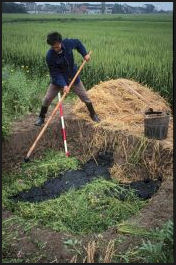
Using human fertilizer
Threshing means removing the grain (seeds) from the plant. Sometimes this is done by trampling the grain and stalks with cattle. Winnowing means removing the husks and chaff and other impurities from the threshed grain. In many villages, winnowing is done with a hand-cranked winnower or by tossing basketfuls of grain upwards into a breeze (the lighter husks blow away while the grain drops down) and grain is crushed into flour with mortars and mallet-like pestles.
On large farms many of agricultural chores are often done with machines like tractors, reapers, threshers and combines. Tractors are most beneficial A reaper is a machine that sorts grain. A combine cuts the grain, separates it from the straw with a powerful fan and deposits the grain from back of the machine to be collected later. A combine can harvest a wheat field when its too wet to cut with a sickle
Many kinds of vegetables and fruits are dried in the road or on blankets before they are stored. Beans are beaten out of their pods (still on the stalks) with poles. To keep away bird farmer use scarecrows and noisemakers and sometimes sleep in the fields and personally shoo away the bird themselves.
Traditional Agriculture Technology in China
Much of the field work is done with heavy, thick-bladed hoes. In some places the harvest of millet, sorghum and wheat are deliberately left out on the roads to be threshed by passing cars that crack the chaff. Rudimentary muscle-powered machines are still used to do things grind corn in Shaanxi Province. Many ethnic minorities in the south use large mortars and pestles to crush grain into flour.
Several different kinds of water pumps, none of them powered a motor or even an animal, are still used in China. In Ningxia Province, water wheels are still fairly common. In Guanxi Province, you can find chain pumps operated by pedaling children. Theroux wrote, “the largest and weirdest — devise he saw “was a gigantic spoon, about ten feet long and made of wood, which a woman used to move water from a lower field to a higher one. She didn't simply lift and dump the water; she scooped and splashed very quickly, and it was all like a laborious form of playing." In recent years mechanical diesel pumps have replaced manual devices in many places.
Some remote areas have been greatly helped by the completion of roads that link fields and farms to major roads. Before that farmers often had difficulty getting their food crops to markets before they rotted. A device with "spring action in which a whole section of discs rises when it hits rocks" makes it is easier to cultivate hard, stony soil and raise crops like alfalfa.
Chinese farmers use a lot of pesticides. Heavy pesticide use has been blamed in the decline in a number of wold animals and birds.
Human Fertilizer in China
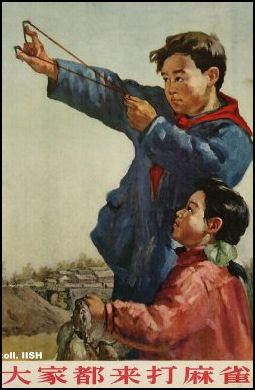
Four pests poster
Nothing is wasted in China: human waste is collected from family outhouses and used as fertilizer. Outhouses in rural China are often placed near the pig sties so waste can be collected from both sources and used for fertilizer. China has a long history of using human excrement—“night soil” — as fertilizer. The morning distribution of night soil is common sight throughout China.
Human waster is still widely used. It is often stored in fields in decorated cauldrons. Human waste is not a big environmental or health concern. More troubling is the factory run-off and medical waste that find its way into the sewer system that produces sludge-based fertilizers laced with heavy metals and toxic chemicals.
Urine is collected in 65-gallon drums and used for medicine and fertilizer. Theroux saw a sign over a urinal at a public restroom that read "We would like good quality urine, so please do not put anything in — no spitting, no paper, no cigarette butts."
It is estimated that the citizens of Shanghai produce over 10,000 tons of human shit everyday and much of it gathered up at night, put in barrels, transported to fields around the city, and scooped out as fertilizer. Until the early 2000s, human waste was moved in Shanghai by boats poled along the city's shallow canals and streams by women. In 2001, 4,700 tons of feces and 19,000 tons of trash traveled to processing stations and landfills by the poled boat. These boats however recently have been replaced by mechanized vessels which cover their cargo with blue traps.
The women who pole the boats begin their tasks at 4:00am as human waste picked up from neighborhoods is delivered by truck and distributed on the boats in construction hats tied to bamboo poles. Loading is usually finished around 7:00am. The process of poling the boats is slow and difficult. Sometimes the women have to jump ashore to pull the boats with ropes tied around their bodies. Some women travel 18 miles a day over a period of up to 15 hours. These days many farmers have switched to nitrogen and phosphorous fertilizer, which run off and cause water pollution.
Pests in China
Farmers have suffered from attacks by locusts and grasshoppers.Mao launched the program to kill the "four pests" (sparrows, rats, insects and flies). Every person in China was issued a flyswatter and millions of flies were killed after Mao gave the directive "Away with all pests!" The fly problem persisted however.
According to Chinese officials a massive locust outbreak was averted in the mid-2000s near the Kazakhstan border through the massive and timely use of pesticides and the consumption of locusts by more than 1 million insect-eating birds. Residents in the area had spent two years building nest for insect-eating starlings that like to eat locusts. Chickens and ducks raised with government subsidies also did their part eating up locusts As of July 2007, locust had destroyed 1.45 million hectares of farmland but officials said the damage would have been much worse without the birds and pesticides
Mice Attack in China
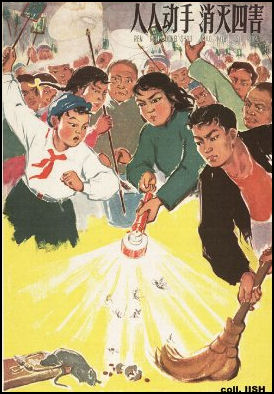
Another four pests poster
In the summer of 2007, the combination of a long drought followed by floods produced an infestation of mice around Dongting Lake in Hunan Province that destroyed thousands of acres of crops and damaging important dikes by burrowed through them to reach crops. By some estimated 2 billion eastern field mice — known locally as rats — overran 22 counties around the lake. .
The were reports of houses in Hunan being inundated with mice driven from their holes by flood waters. A farmer woke up one morning to find his fields destroyed by mice told the Washington Post, “You can hear them as they bite the rice — chir, chir chir. It’s deafening.” Another said, “You can easily step on them just by walking on the road, the are so many.”
A massive mice cull was conducted and people were put on the alert for rodent-caused disease. Efforts to poison them worked to some degrees by also killed cats, dogs, cows, chickens and pigs. Television footage showed residents of Yoyang city beating mice to death with clubs and shovels. Others were caught with fishing nets and drowned and poisoned. Over a five week period 2.3 million mice — 90 tons of them — were killed. . Most were buried in deep pits under layers of lime o prevent the spread of disease.
A drought that lasted through much of the fall, winter and spring, reduced the water levels in Lake Dongting Lake around the cities of Bianhu and Yueyand in Hunan, producing condition ideal for mice breeding. When the gates of the sluice on Three Gorges Dam were opened to relieve flooding water from the Yangtze poured into the lake, causing the mice to flee for high ground. Witnesses said the scene was like a movie about the Apocalypse.
Overpopulations of mice are also being blamed on the harvesting of snakes for food. Snakes can consume up to 400 mice year. To prevent a rat infestation in the future around Dongting Lake there is some discussion of erecting a 40-kilometer-long, one meter-high wall to keep the rats out. Environmentalists say human activity, namely those that have led to a decrease in natural enemies of rats such as snakes and owls, around the lake is the primary cause of the rat problem.
Natural Pest Fighters in China
Chinese farmers often use natural enemies of common pests to keep the pests under control. For centuries they raised weaver ants to protect their citrus orchards from fruit-eating insects and used ant predators to eat herbivorous insects that ate grain.
Today many farmers in China raise trichogramma wasps — a species native to Africa and one of the smallest insects in the world — in little plastic pagodas and nourish them with oak silkworm eggs to destroy the eggs of fruit- and corn-eating wasps.
Under Mao Zedong, the government regularly sponsored rat extermination campaigns. In recent years the government has trained Siberian foxes to hunt rats that are destroying crops and woodlands in northwest China.
Image Sources: 1, 2, 7, 8, 10) Columbia University; 3, 4, 6, 11, 12 ) Nolls China website http://www.paulnoll.com/China/index.html ; 5) Louis Perrochon ; 9) FAO; 13) Agroecology; 14, 15) Landsberger Posters http://www.iisg.nl/~landsberger/
Text Sources: New York Times, Washington Post, Los Angeles Times, Times of London, National Geographic, The New Yorker, Time, Newsweek, Reuters, AP, Lonely Planet Guides, Compton’s Encyclopedia and various books and other publications.
Last updated November 2011
